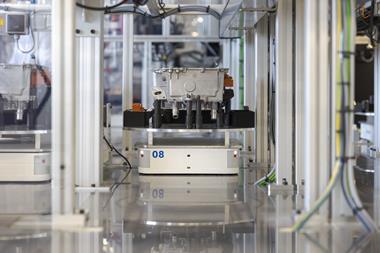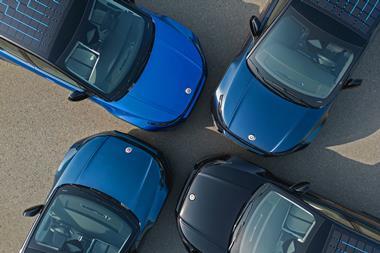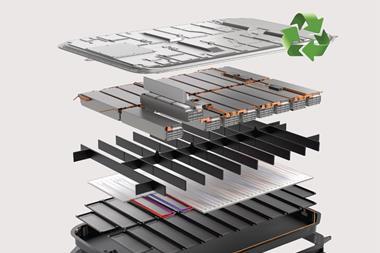Under government pressure, domestic and international OEMs in China are switching to new-energy vehicles
Another target is for half of Chinese-made cars to have driver assistance and basic autonomous driving by 2020, rising to 80% by 2025. The government sees vehicle connectivity as being central to the future of transportation and is directing its major companies to focus R&D in this area. Many OEMs’ plans are still being worked out but Changan has already announced that it will invest 21 billion yuan ($3.1 billion) over the next ten years to expand its smart-car research team from 600 to over 2,000 people.
Change is imminent in other ways, too. The major automotive manufacturing groups FAW and Dongfeng have suffered significant losses in recent times, leading to speculation that a merger might be encouraged by the authorities. In parallel, there is likely to be a shake-out of domestic players, with a few big companies taking an ever-larger market share. Currently, four domestic vehicle-makers – Guangzhou, SAIC, Geely and Great Wall – take around 45% of the market, with some Chinese analysts suggesting that this will rise to over 60%. Guangzhou (GAC) broke ground on a new EV factory in Panyu in April this year, with capacity for 200,000 units per year from 2018, later rising to 300,000. This investment, totalling 45 billion yuan up to 2025, will support a long-term objective to make high-connectivity and autonomous models as well. Meanwhile, the continued rise of Geely will be underpinned by its new brand, Lynk & Co, producing models heavily dependent on technology from Volvo, which the Chinese company bought in 2010.
Alongside such changes among Chinese OEMs, vehicle-makers from around the world have continued to invest in the country, as discussed below.

US vehicle manufacturers■ Ford’s activities in China centre on its JV with Changan, which involves five factories with a total annual capacity of 1.6m units. The company’s next known move in the country will involve EVs; the Mondeo Energi will become the first hybrid made by a Ford Changan plant when it starts production later in 2017 ahead of a market launch in 2018. Furthermore, a small full-electric SUV will be produced within five years. In line with the Chinese government’s wishes for vehicle-makers to refocus on EVs, Ford plans to electrify 70% of its model range in the country. Initially, the OEM will import the necessary powertrains but expects to produce them in China by 2020.
In addition, Ford is understood to be planning to make Lincoln models in China by 2019, having seen GM already add Cadillac production. Ford is also looking at introducing pick-ups, especially high-specification versions – at first imported but made locally in the long term.
Read the interview with Bill Russo, Ford’s manufacturing vice-president for China, here.
■ GM recently announced its withdrawal from vehicle production in Europe, India and South Africa but it remains committed to China and operates JV facilities with SAIC. GM has added Cadillac production to compete directly with locally manufactured Audis, BMWs and Mercedes models instead of paying 25% import duty, but it has also launched an entry-level brand, Baojun. The OEM uses its Chinese facilities to make the Buick Envision crossover for global markets, including exports to the US. Its focus on SUVs and crossovers in the country is especially apparent at the Cadillac plant in Shanghai which opened in 2016. The factory is capable of making 160,000 vehicles a year but is currently running at half this rate, producing the CT6, XT5 crossover and the Buick GL8 MPV.
In addition to expanding vehicle production in China, GM will build an EV battery plant in the country. This will help it to meet the government’s requirement for 8% of output to comprise EVs and will also reduce GM’s dependence on Korean battery manufacturers.
 ■ FCA has been making Jeeps in China for more than three decades and in the past few years has expanded its line-up together with partner GAC. In late 2015, the company celebrated its first locally produced Jeep Cherokee, made at the Changsha plant, and confirmed plans to add two more models by the end of the year, including the Renegade. FCA GAC opened a second facility in Guangzhou in April 2016.
■ FCA has been making Jeeps in China for more than three decades and in the past few years has expanded its line-up together with partner GAC. In late 2015, the company celebrated its first locally produced Jeep Cherokee, made at the Changsha plant, and confirmed plans to add two more models by the end of the year, including the Renegade. FCA GAC opened a second facility in Guangzhou in April 2016.
Premium European brands■ BMW is experiencing a very positive period in China, outselling Mercedes and Audi. In April 2017, it sold nearly 49,000 units in the country, a 39% year-on-year increase, while its year-to-date sales were up 18% to nearly 192,000. This increase helps to explain the company’s decision to boost production capacity in the country, first to 450,000 and possibly to 600,000 by 2022. Currently, BMW operates two plants in Shenyang; the one in Tiexi district makes the 1-Series, normal and long-wheelbase 3-Series, a long-wheelbase X1 and the 2-Series; the sister plant in Dadong district produces the long-wheelbase 5-Series and is being modified to accommodate large SUVs, starting with the X3 and possibly adding the X5 later on.
■ Mercedes produces a wide variety of models in China at its JV plant with Beijing Automotive, BBAC, including long-wheelbase versions of the C- and E-Class solely for the Chinese market. It also makes vans in the country, starting with the Vito in late 2016. These are produced in a second JV plant, Fujian Benz in Fuzhou, where €200m ($237.8m) have been invested to make not only the Vito van but its passenger version, the V-class (Viano in Europe).
Like other vehicle-makers, Mercedes’ parent company Daimler is looking at EV and battery production in China as well as in its European plants. The Chinese-made batteries would be used on a wide variety of models, including a future hybrid A-class, the next version of which is due in 2018. One challenge in China will be the use of the EQ name for Mercedes EVs; Chinese producer Chery has used the eQ name for one of its own EVs for the last two years and has reportedly already complained to the trademark authorities.
The Chinese motorcycle manufacturing industry is the largest in the world, even though output has been declining over the last five years. In 2016, Chinese OEMs made just over 16.8m motorcycles, slightly more than 14.7m two-wheelers and nearly 2.1m three-wheelers, according to the Chinese Association of Automobile Manufacturers. In 2016, exports were a little over 6.9m, suggesting a domestic market of around 10m motorcycles a year. Most exports – nearly 6.7m – were two-wheelers.
Although there are more than 200 motorcycle manufacturers in China, the vast majority operate under brand names unknown in the West; key producers include Grand River, Lifan, Loncin and Zongshen. These makers are largely focused on the domestic market and emerging-market exports, with Asia, Africa, Russia and Latin America accounting for close to 90%. However, some Chinese companies have joint ventures with international brands, such as Loncin with BMW, Zongshen with Piaggio and Qingqi with Suzuki and Peugeot.
In recent times, domestic demand has been hit by motorcycle bans in some Chinese cites. This fall was compounded by a slowdown in the rural economy, where motorcycles are a key mode of transport for both goods and people. Yet figures for March suggested that the bottom of the downturn had been reached; production and exports both increased.
Chinese motorcycle production is likely to remain the largest in the world, and still centred on the domestic market and emerging-market exports. North America, Japan and Europe generally focus on cross-supply between these markets rather than sourcing from China; there is little sign of this changing.
Crucial to the anticipated turnaround will be continued expansion of PSA’s manufacturing network in the country. Its fourth Chinese plant, at Chengdu, opened at the end of 2016 and produces the 4008 (equivalent to the 3008 in Europe), while a sister plant in Shenzhen concentrates on PSA’s premium brand, DS, including the DS7 crossover which is also due to start production in France in H2 2017.
■ Renault was the last of the major global brands to enter China, opening its first factory as a JV with Dongfeng in January 2016. Reflecting the market’s orientation towards SUVs, the Renault plant makes the Kadjar and Koleos models. The facility will make around 70,000 vehicles in 2017, but has the capacity for double this and the potential for 300,000, subject to further investment. The Kadjar for China, which will feature technologies not currently available in Europe for this model, may be joined by the small Captur SUV that is imported from Spain.
■ Meanwhile, Renault’s partner, Nissan, has started production of its Navarra pick-up truck at Zhengzhou, following a relaxation of regulations. Such vehicles were banned from city centres, but since February 2017 models which meet the same emissions standards as passenger cars in five provinces – Hebei, Henan, Hubei, Liaoning and Yunnan – as well as the city of Chongqing can be used in urban environments.
■ Volkswagen’s next round of expansion in China focuses on SUVs and EVs. For example, the Tiguan L, a seven-seater long-wheelbase version of the mid-sized Tiguan, will be made at the Shanghai-VW JV, as well as in Germany and Mexico. VW now also has a JV with JAC, established to make what it calls “affordable” EVs for the Chinese market. This partnership has been set up to cover a 25-year period, with an annual capacity of 100,000 units. Some reports have suggested that the Seat brand may be used to sell these EVs, in order to differentiate them from VW models. Seat sales were discontinued in 2014 after two unsuccessful years on the Chinese market.
VW previously said that it would make 400,000 new-energy vehicles a year in China, some of which will be made at the company’s JVs with FAW and Shanghai SAIC. In 2020, VW also plans to add Chinese production of the I.D. EV – a new model based on the electric MEB platform, which starts production in Germany in 2018.
 Volvo’s first full EV will be made in China from 2019. It will be based on the new Compact Modular Architecture (CMA)
Volvo’s first full EV will be made in China from 2019. It will be based on the new Compact Modular Architecture (CMA)■ Volvo had struggled to develop as a global brand, either when independent or under the ownership of Ford. However, since being taken over by Geely, Volvo has both transformed its product line-up and also expanded its manufacturing network into a global one, capable of making 800,000 vehicles a year by 2020.
China is very much at the heart of developments in both areas; Volvo’s first full EV will be made in China from 2019, based on its new small/ compact-car Compact Modular Architecture (CMA). This EV and other models based on the CMA will be built at a new plant currently under construction at Luqiao in association with Geely. This factory will make Volvos and models to be sold under Geely’s new Lynk & Co brand, sharing the CMA platform. It will be the third Volvo car factory in China.
At Daqing, Volvo makes the S90 while its Chengdu plant produces the current 60 series and will soon switch to the next-generation 60 series vehicles. Effectively, Volvo will have one plant in China for each of its product lines, each capable of making at least 150,000 units a year, potentially more. The Daqing plant will become the sole global supply point for the S90 from mid-2017.
Japanese and Korean OEMs■ Long-established in China, Honda is joining the switch to EV production and will produce its first EV for the country by the end of 2018. It is not known which model this will be, but reports suggest that it will be made at the Honda-Dongfeng JV in Wuhan. Certainly, investment there is substantial; a $435m plant is under construction and due to open in mid-2019. This factory will launch with an annual capacity of 120,000 units, potentially rising to 240,000.
■ Toyota has been relatively quiet in China through the early years of this decade. In 2015, it announced a new plant in the country which will open in 2018, its first investment since a moratorium on additional manufacturing facilities was implemented in 2013.
 The Toyota Guangzhou plant will make the CH-R from 2017
The Toyota Guangzhou plant will make the CH-R from 2017Ahead of this new plant coming on stream, two existing JV factories, with FAW and Guangzhou, will both make versions of the C-HR compact crossover, with a market launch during 2017. Toyota is also opening a new R&D facility in the country to focus on hybrid technologies.
■ Currently, Hyundai has around 1.2m units of annual capacity in China, along with Kia’s 900,000. Recent press reports suggested that Hyundai is considering adding two more plants in China, each capable of making 300,000 vehicles per year, focusing on environmentally-friendly models. As part of a policy of boosting Korea’s image and profile in China, Hyundai has recently chosen a Chinese battery supplier for hybrid models made in the country. This renewed commitment to China, reported in May 2017, follows on from earlier reports of production cutbacks at both Hyundai and Kia in China as a result of diplomatic disputes between the two countries.
China’s automotive components sector has expanded significantly in recent years in line with increased vehicle production in the country, writes Ian Henry. This growth has been underpinned by a programme of continuous investment by global tier-one suppliers through joint ventures or wholly owned subsidiaries, in support of the growing vehicle plants of international OEMs.
One of the emerging trends in China is the establishment of supplier parks which have been a feature of European vehicle manufacturing networks for decades. The Chinese version focuses on electric vehicles (EVs) and a prime example is the park being developed by Guangzhou Automobile Group (GAC) at Panyu, where it is investing $679m in a new EV plant to open by the end of 2018 and make 200,000 vehicles a year. This park has already attracted Aisin Seiki, Continental, Faurecia and Michelin; ten global tier-ones will ultimately be located there. Another such park is being opened by electric bus specialist BYD in Yinchuan.
Chinese component suppliers have grown in their home market, mainly through JVs, but have also begun to expand abroad, for example Yanfeng in interiors and Hebei Lingyun Industrial Group, which has acquired the German lock and latch company Kiekert. However, as Chinese suppliers start to become global players, their home markets remain dominated by international players, which have made a range of recent investment announcements, as summarised below.
Adient said in April that it will build a seat mechanism plant in Changshu in a JV with Yanfeng. Equipped with machinery for stamping, electrophoretic painting, welding, fine blanking and heat treatment, the factory will supply seat tracks, adjusters, latches and related parts used in seat mechanisms to seat assembly factories in China, as well as exporting sub-assemblies to Adient’s overseas plants. Operations are due to begin by the end of 2018.
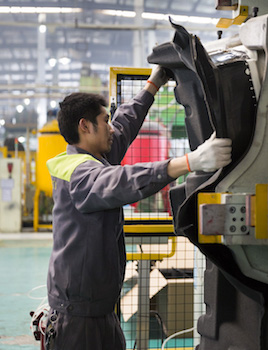 Autoneum has opened its seventh Chinese plant
Autoneum has opened its seventh Chinese plantAntolin, one of the global leaders in headliners and door panels, opened a JV plant with Dongfeng Visteon in Wuhan last year. It will supply Renault, PSA, Honda, Nissan and Infiniti factories.
Autoneum, a major player in acoustics and thermal management, has opened its seventh plant in China, at Yantai, to produce inner dashboard parts and carpets. The factory will start operations in 2017 and be able to supply up to 250,000 vehicle sets per annum. One of the notable aspects of this new plant is the focus on its long-term sustainability, with production waste such as polyester or mixed-fibre fleece to be recycled and reused onsite.
Benteler of Germany has spent $20m on opening a new factory in Shenyang to supply BMW’s JV. The plant will produce a range of chassis, body, engine and exhaust components for the 3- and 5-Series sedans and the X1 SUV.
Bosch has unveiled a new electronics components plant in Guangzhou, having invested €100m ($117.1m). The factory will focus on autonomous driving and connected products, including cameras, radar sensors and steering-system electronic control units, with plans to make around 41m of the latter a year by 2019.
Brose has opened new headquarters in Shanghai to coordinate the activities of its 12 factories in the country as well as those in Korea, Thailand and Japan. The Asian region as a whole now represents more than 20% of company turnover and is expected to reach 25%, or around €2 billion, by 2025. Brose’s growth will be centred on the expansion of its offerings for 48-volt applications, especially for power steering and automatic side-door closing systems.
Faurecia has been growing in China via a series of JVs which have been established to meet the needs of its expanding core customers, PSA and Renault, especially for seats and exhaust systems. Faurecia and Borgward (a Chinese company with the right to use an old German name) will make up to 400,000 seat sets a year in China by 2020. A new factory in Tianjin will initially be a just-in-time assembly facility, but will ultimately add production of seat frames, seat foam and seat covers, including some components which are currently imported. The first vehicle to use these seats is expected to be the Borgward BX5 SUV. In future, the factory will also make cockpits, though the timing is unconfirmed.
Ficosa, the Spanish supplier of mirrors, brakes, gear shifts and cables, has expanded in China in order to supply mirrors and parking brakes to BMW, Great Wall and BAIC. Its new owner, Panasonic, has itself opened a new lithium-ion battery in Dalian, a JV with Dalian Leaver Electric Co.
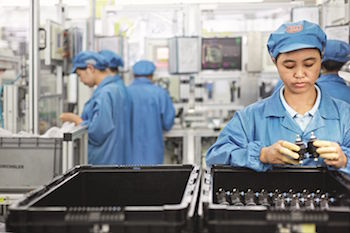 Hella has a Shanghai site (above) but is also expanding in Wuqing
Hella has a Shanghai site (above) but is also expanding in WuqingHella has a joint venture, Hella-BHAP, with Beijing Hainachuan Automotive Parts Co, which is expanding its production capacity for lighting in Wuqing. The extra capacity will come on stream in October 2017 and serve BBAC (the Mercedes JV) and BAIC, initially with headlights and later moving onto other lighting products.
IHI, one of the two major Japanese turbocharger suppliers (alongside MHI), has just announced a major investment programme to expand turbocharger production. The company will invest 1 billion yen ($9m) at its Wuxi IHI wholly owned subsidiary in Jiangsu.
Inteva, the former Delphi interiors business, opened a new plant in Wuhan in 2015 as part of its global expansion. This plant, which produces roof systems for Guangzhou Fiat, was followed by another in Zhenjiang, the company’s eighth factory in the country.
Magna announced a new plant for its Dongfeng Getrag JV in Wuhan in 2016. This factory will produce the 6DCT150, a third-generation, dual-clutch transmission which will be used in front-wheel-drive transverse applications, mainly small/compact cars.
Valeo has made a series of investments and expansions and now has around 30 plants in the country, employing over 15,000 people. The company focuses on lighting and electronic systems.

























